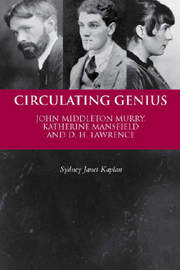Book contents
- Frontmatter
- Contents
- Acknowledgements
- Abbreviations
- Introduction
- 1 ‘My Blundering Way of Learning’: Murry's Still Life
- 2 Still Life and Women in Love
- 3 From Still Life to ‘Bliss’
- 4 ‘A Furious Bliss’
- 5 ‘With Cannonballs for Eyes’
- 6 ‘The Coming Man and Woman’
- 7 The Things We Are
- 8 Circulating Mansfield
- 9 Circulating Lawrence
- 10 Circulating Murry
- Bibliography
- Index
1 - ‘My Blundering Way of Learning’: Murry's Still Life
Published online by Cambridge University Press: 12 September 2012
- Frontmatter
- Contents
- Acknowledgements
- Abbreviations
- Introduction
- 1 ‘My Blundering Way of Learning’: Murry's Still Life
- 2 Still Life and Women in Love
- 3 From Still Life to ‘Bliss’
- 4 ‘A Furious Bliss’
- 5 ‘With Cannonballs for Eyes’
- 6 ‘The Coming Man and Woman’
- 7 The Things We Are
- 8 Circulating Mansfield
- 9 Circulating Lawrence
- 10 Circulating Murry
- Bibliography
- Index
Summary
John Middleton Murry's first novel, Still Life, published in 1916, was considered a failure by friends and critics alike. Lawrence complained that it was ‘the kind of wriggling self-abuse I can't make head or tail of’ (LDHL 3: 53). His complaint conceals a troubled history of his relations with Murry, but it astutely addresses one of modernism's most significant critical problems: how to combine the new psychological awareness of the moderns with a literary form that would control the inevitable tendency to self-disclosure, a subject Murry was interrogating in his concurrent critical writing. The density of his novel results from Murry's refusal to simplify, condense or symbolise, a function of his need not to ignore any aspect of what he believed to be ‘the psychological truth’.
I should say at the start that I am not suggesting that Still Life is a lost masterpiece nor that Murry's fictional talents should have been encouraged. Murry himself recognised his limitations. Although he persevered through the writing of two more novels after Still Life, he came to the conclusion that writing fiction was ‘merely my blundering way of learning – as always by hard experience – that I was not a novelist’ (BTW: 259). His failure partially stems from a conception of the novel still dependent upon nineteenth-century narrative conventions. Murry's narrative practice stumbled behind his critical theory.
- Type
- Chapter
- Information
- Circulating GeniusJohn Middleton Murry Katherine Mansfield and D. H. Lawrence, pp. 13 - 37Publisher: Edinburgh University PressPrint publication year: 2010



